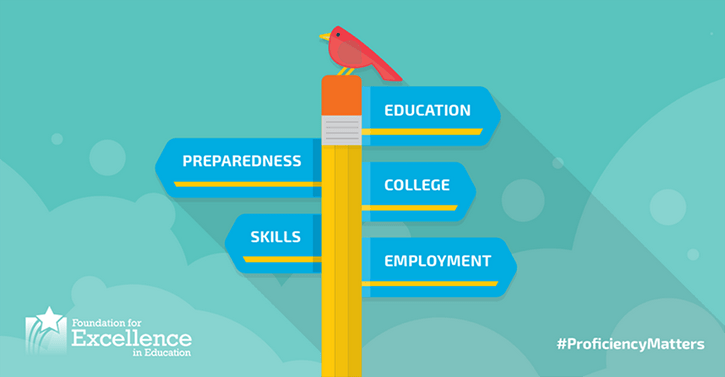Why Proficiency Matters

Cari Miller
Please raise your hand if you’re ready for the back-to-school craziness to start already.
While I’m not ready for summer break to end just yet, I am excited to see how much my daughter Camryn will learn and accomplish throughout the coming school year.
Camryn will soon receive her first round of quarterly grades which will provide a decent indicator of how well she is doing in her classes. But grades are just one indicator. The formative assessments she will take throughout the school year help me understand her progress even more. And, tests at the end of the year help me know if she has mastered all grade-level content and is ready for the next grade.
For Camryn, end of the year assessments provide her with the opportunity to shine. For me, they offer honest, objective information on how my daughter is doing. These assessments inform me and her teacher whether or not Camryn is mastering the core subjects she will need to succeed at the next academic level and in the real world.
But what if the state assessments or Camryn’s school grades weren’t a true reflection of her work and performance? What if her A-grade work was comparable to B-grade or C-grade work in another state? What if a high score on the state assessment wasn’t so great when compared to another state’s higher expectations?
These questions aren’t just hypothetical. In many states, students can earn passing scores on state tests, advance to the next grade and even graduate from high school without mastering essential skills. And this has devastating effects.
- 50 percent of students entering two-year colleges are placed in remediation. (Source: Complete College America, Remediation: Higher Education’s Bridge to Nowhere, 2012)
- $7 billion is spent annually by first-year college students to learn what they should have mastered in high school. (Source: National Bureau of Economic Research, Improving the Targeting of Treatment: Evidence from College Remediation, 2012)
- There are 600,000 vacant American manufacturing jobs due to the lack of qualified applicants. Over the next decade that number will likely grow to 2 million. (Source: The Manufacturing Institute, The Growing Skills Gap Report, 2013 & Deloitte: The Skills Gap in U.S. Manufacturing 2015 and Beyond)
When states set low expectations for proficiency, they lead parents and teachers to believe students are performing better than they actually are. This is why proficiency matters in state assessments.
Every state draws a line – also called the proficiency cut score – on their annual assessment to determine if a student is proficient in the subject. This proficiency cut score varies state by state. When the cut score is too low, students and families are the ones who suffer.
The respected National Assessment of Educational Progress (NAEP) is considered the gold standard for measuring student proficiency. The difference between NAEP and individual states’ proficiency expectations are wide and varied. This discrepancy is called a “proficiency gap.”
Last month, the Foundation for Excellence in Education (ExcelinEd) introduced WhyProficiencyMatters.com, a research-based tool to help parents understand what proficiency means in their state and how the proficiency gap impacts their children.
WhyProficiencyMatters.com presents the facts, data and analyses on proficiency expectations in all 50 states. This interactive site empowers parents to understand the importance of high proficiency expectations and to explore the proficiency gap in their state.
In my home state of Florida, for example, the state indicated that 60 percent of fourth-grade students can read proficiently. However, NAEP research found that only 39 percent of fourth-grade students can read proficiently. Florida has a 21 percent proficiency gap in actual student achievement for fourth-grade reading, indicating that expectations are on the easy side and aren’t as meaningful as they could be.
As parents and education stakeholders, we need to share this information with our school leaders, education officials and local representatives. Many do not know these facts or understand the consequences it has for our children’s future success.
We can create education systems where every child masters the knowledge and skills necessary to be successful in the next grade – and most importantly – after high school. And we can start by raising proficiency expectations and believing our students are capable of accomplishing great things.
For more, check out:

Cari Miller serves as State Policy Director of K-3 Reading for the Foundation for Excellence in Education. Follow ExcelinEd on Twitter, @ExcelinEd.







0 Comments
Leave a Comment
Your email address will not be published. All fields are required.